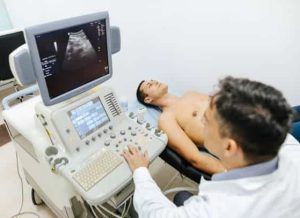3D Pelvic Ultrasound Scan
3D Pelvic Ultrasound Scan
£245
In Private Ultrasound Clinic, we offer 3D Pelvic ultrasound for a detailed evaluation of the Uterus (Womb), Ovary, and the Lining (Endometrium). This Ultrasound scan provides you with the detailed necessary Information about Your womb & ovaries especially if you suffer from a different medical condition in your lower abdomen or if you have a plan to conceive naturally or with IVF.
3D Pelvic Scan is a detailed gynaecological Ultrasound assessment of your pelvic organs: womb, the lining of the womb, ovaries, diseases of the fallopian tubes, and surrounding structures.
This type of scan aims to rule out any structural cause that might explain the symptoms you are experiencing, such as abnormal vaginal bleeding, infrequent periods, difficulty conceiving, recurrent miscarriages, bloating, generalized pelvic pain or any other related issue.
This scan is generally performed in two parts: transabdominally with a full bladder (on top of the tummy) and transvaginal (internal scan), with transvaginal views giving the most details in 3D imaging.
Book Your Appointment
Please select a location and time slot to proceed with the booking
If you are unable to make a payment online, please call our office to book your appointment. We’re here to assist you!
Tel: 020 7101 3377
Our Latest Google Reviews
EXCELLENTTrustindex verifies that the original source of the review is Google. Fantastic and hugely efficient service. Hana, the Cardiologist, was absolutely great - very knowledgeable with a great bedside manner. Thank you. Please don’t publish my name.Posted onTrustindex verifies that the original source of the review is Google. Excellent servicePosted onTrustindex verifies that the original source of the review is Google. Excellent servicePosted onTrustindex verifies that the original source of the review is Google. Excellent, professional and explained what was happening. Would highly recommendPosted onTrustindex verifies that the original source of the review is Google. A good experience all round. Helpful and friendly staff.Posted onTrustindex verifies that the original source of the review is Google. Great experience being treated special. It is very obvious that they value their clients. The sonographer assigned to me is very accommodating and knowledgable. Great experience.Posted onTrustindex verifies that the original source of the review is Google. I had a very good experience at the ultrasound clinic yesterday. I found them through their website and was able to book an appointment in the evening for the very next day. I met very helpful and professional doctors, and I just want to say thank you very much. I highly recommend this clinic to anyone who needs help!Posted onTrustindex verifies that the original source of the review is Google. Extremely professional from start to finish. I was reassured and given options for other tests that I didn’t think of. Thank youPosted onTrustindex verifies that the original source of the review is Google. Very relaxing, understanding and so helpful. Dr Reza see me and he was so patient and understanding and explained so much to me. Definitely recommend
Private 3D Pelvic Ultrasound in London & Across the UK
Book a same-day 3D pelvic ultrasound (2D/3D/3D Doppler) for gynaecology, fertility and pregnancy. If you searched for “3D pelvic scan,” “3D ultrasound London,” “scan of womb and ovaries,” “pre-conception ultrasound scan,” “transvaginal ultrasound London,” or “private pelvic ultrasound near me,” this page explains what 3D ultrasound shows, how it differs from standard 2D, who should consider it, the procedure, preparation, limitations, results wording, prices, and how to book.
What is a 3D pelvic ultrasound?
3D pelvic ultrasound is an advanced sonographic technique that acquires a volume dataset of the pelvis. From that dataset, we can reconstruct coronal and off-axis planes of the uterus and cervix that standard 2D cannot readily show. It provides precise assessment of uterine shape (septate/bicornuate), endometrial contour, intracavitary pathology (polyps, submucosal fibroids), myometrial lesions (fibroids, adenomyosis features), and the ovaries and adnexa.
In short: 2D shows the slice; 3D shows the structure. For many gynaecology and fertility questions, that structural context is decisive.
2D vs 3D vs Doppler: what’s the difference?
- 2D greyscale – First-line. High-resolution slices of the uterus, endometrium, ovaries. Fast, detailed, excellent for most routine assessments.
- 3D volume – Adds a volumetric dataset, enabling true coronal plane of the uterus and multiplanar review. Helpful for uterine anomalies, endometrial shape, submucosal fibroids, niche defects, IUD position, and surgical planning.
- Colour/Power Doppler – Shows blood flow. Useful for endometrial/lesion vascularity (e.g., polyp pedicle), fibroid perfusion, and adnexal masses. 3D Power Doppler (when indicated) can display vascular maps of lesions.
Who should consider a 3D pelvic scan?
3D is particularly helpful if you have any of the following:
- Irregular or heavy periods, intermenstrual bleeding, or post-menopausal bleeding.
- Fertility evaluation (pre-conception ultrasound, follicle tracking, suspected uterine anomalies affecting implantation).
- Suspected fibroids or polyps, especially when planning hysteroscopic resection or myomectomy.
- Pelvic pain possibly related to adenomyosis/endometriosis (with an endometriosis-protocol scan).
- IUD position check (including malposition or embedment), Caesarean scar niche assessment.
- Clarifying congenital uterine anomaly (septate, bicornuate, arcuate, didelphys).
- Early pregnancy reassurance (dating/viability) with optional 3D rendering when appropriate.
Common clinical indications we scan
- Abnormal uterine bleeding – assessing endometrial thickness, focal lesions (polyp/submucosal fibroid), global pattern.
- Fibroids (leiomyomas) – mapping number, size, location (submucosal, intramural, subserosal), and distortion of the cavity.
- Endometrial polyps – 3D contouring and Doppler “feeder” can suggest polyp vs soft submucosal fibroid.
- Adenomyosis features – asymmetry, myometrial cysts, fan-shaped shadowing, junctional zone irregularity on 3D.
- Ovarian assessment – follicles, cyst characterisation, PCOS morphology (when clinically relevant), corpus luteum.
- Congenital uterine anomalies – 3D coronal plane is ideal to differentiate septate vs bicornuate uterus.
- Cervix – length/shape, polyps, Nabothian cysts; 3D can help in niche/defect analysis.
- IUD/implant location
Preparation & best timing in the cycle
- Timing: For bleeding or cavity concerns, the early proliferative phase (days ~5–10) often yields optimal views. For follicle tracking, timing is tailored to your cycle/medication schedule.
- Bladder: For transabdominal views, a moderately full bladder helps; for transvaginal (TVS), you’ll be asked to empty the bladder.
- Comfort & consent: TVS is optional; we explain and obtain consent. A chaperone is available on request.
- Attire: Wear comfortable clothing; you may need to remove tights/underwear for TVS.
Note: Scans can be performed during light bleeding if clinically urgent, but non-urgent endometrial evaluation is clearer off menses. TVS is generally safe in early pregnancy when clinically indicated.
What happens during the scan
- History & goals: We confirm your symptoms (pain, bleeding, fertility), cycle day, and any prior imaging.
- 2D survey: Transabdominal and/or transvaginal imaging of uterus, endometrium, ovaries, adnexa.
- 3D acquisition: A volume sweep creates a dataset. We reconstruct the true coronal plane, assess contour and intracavitary detail, and generate multiplanar views.
- Doppler (when indicated): Colour/Power Doppler helps evaluate lesion vascularity, ovarian flow, or polyp stalks.
- Measurements & mapping: We measure endometrial thickness, fibroid dimensions, ovarian volumes/follicles; we document number and location on a diagram where useful.
- Feedback & report: You’ll receive verbal impressions and a structured written report shortly after with images and key measurements.
Typical findings & how reports are worded
- Normal study: “Uterus normal in size and echotexture. Endometrium thin, smooth (x mm) for phase. Ovaries normal with follicles. No adnexal mass or free fluid.”
- Polyp suspected: “Focal endometrial projection with smooth contour on 3D coronal; colour Doppler demonstrates a single feeding vessel—features suggest polyp.”
- Submucosal fibroid: “Intracavitary distortion on 3D coronal; FIGO type 1 submucosal fibroid 1.8 cm with moderate vascularity.”
- Uterine anomaly: “3D coronal demonstrates septate uterus with normal external fundal contour; septum length x mm.”
- Adenomyosis features: “Asymmetric myometrium with subendometrial echogenic lines, myometrial cysts, and fan-shaped shadowing; 3D junctional zone irregular.”
- PCOS morphology (if applicable): “Bilateral enlarged ovarian volumes with peripheral follicle distribution and increased follicle count, interpret in clinical context.”
Fertility, pre-conception & follicle tracking
For patients planning pregnancy or undergoing assisted reproduction, 3D pelvic ultrasound complements clinical care by:
- Confirming a normal uterine cavity (or defining anomalies) before embryo transfer or conception.
- Mapping submucosal fibroids/polyps that could affect implantation—useful for surgical planning.
- Follicle tracking to monitor follicular growth and endometrial development across the cycle or stimulation.
- Checking IUD position before removal/attempting conception, or evaluating a Caesarean scar niche.
3D ultrasound in early pregnancy
Clinically, 2D is used to confirm intrauterine pregnancy, cardiac activity, crown–rump length, and to exclude ectopic pregnancy when appropriate. 3D can add context (uterine anomalies, niche) and optional rendered views. “Keepsake” imagery may be available, but medical safety and diagnostic clarity remain the priority.
Timing: Viability scans are typically from 6–8 weeks. Gender/face 3D keepsake images are later (usually after 20+ weeks), but for medical gynaecology, 3D is valuable throughout.
Endometriosis & adenomyosis protocols
While ultrasound does not directly visualise microscopic endometriosis, a focused protocol can identify ovarian endometriomas, deep endometriotic nodules in accessible locations (e.g., rectovaginal septum), tethering, and adenomyosis features. 3D improves assessment of the junctional zone and cavity distortion. When suspicion remains high and ultrasound is inconclusive, MRI may be suggested for staging.
Limitations & when MRI is helpful
- Body habitus or bowel gas can limit views on transabdominal imaging; TVS improves resolution when appropriate.
- Very small intracavitary lesions may still require saline infusion sonography (SIS) or hysteroscopy for definitive evaluation.
- Deep endometriosis outside ultrasound window or complex pelvic adhesions may be better staged with MRI.
- 3D accuracy depends on high-quality acquisition and experienced interpretation.
Prices & what’s included
Private 3D pelvic ultrasound prices in London/UK typically range from £160–£320 depending on scope:
- Gynaecology 2D + 3D (uterus, endometrium, ovaries, adnexa)
- Fertility/Pre-conception (with follicle tracking as requested)
- Endometriosis/Adenomyosis protocol (extended study)
- Early pregnancy viability with optional 3D render
Your fee usually covers: appointment, scanning (2D/3D/colour Doppler as indicated), verbal summary and a consultant-approved report with images. Package options (e.g., repeat follicle tracking, combined groin/pelvis, or addition of 3D Doppler) may be available.
Locations & “near me” availability
- Central London Branch: 27 Welbeck Street, London, W1G 8EN
- St Albans Branch: 54-56 Victoria Street, St Albans, AL1 3HZ
Frequently asked questions (FAQs)
What is a 3D pelvic ultrasound and how is it different from 2D?
3D acquires a volume so we can see the true coronal plane of the uterus and reconstruct views from multiple angles, improving detection of structural anomalies and intracavitary pathology compared with 2D slices alone.
Is a 3D pelvic scan internal?
We often combine transabdominal (across the lower tummy) with transvaginal (TVS) for the highest resolution. TVS is internal but usually well tolerated, explained beforehand, and entirely optional—you can decline at any time.
Can I have a scan while on my period?
Yes if clinically urgent. For endometrial detail, the early proliferative phase (after bleeding) is usually better. For pain or mass evaluation, timing is flexible.
What will a pelvic ultrasound detect?
Uterine size/shape, endometrial thickness and contour, polyps, fibroids, adenomyosis features, ovarian cysts/follicles, adnexal masses, and—when clinically indicated—signs suggesting endometriosis and IUD position.
Is 3D ultrasound safe?
Yes. Ultrasound uses sound waves (no radiation). We follow ALARA principles and utilise 3D only when clinically indicated or requested.
How long does the scan take and when will I get results?
Typically 25–40 minutes depending on complexity. You’ll receive same-day verbal impressions and a written report with images shortly after.
How do 3D scans help with fertility?
3D precisely defines the uterine cavity and anomalies, maps submucosal fibroids/polyps, checks IUD position, and supports follicle tracking and endometrial monitoring.
Can 3D diagnose endometriosis?
Ultrasound can detect endometriomas and some deep nodules with a dedicated protocol; 3D adds uterine junctional zone detail. However, not all endometriosis is visible on ultrasound; MRI or surgical evaluation may be advised for full staging.
How much does a private 3D pelvic ultrasound cost?
In London/UK, typical pricing is £160–£320 depending on scope (gynae, fertility, endometriosis protocol, early pregnancy with 3D).
Book a Private 3D Pelvic Ultrasound
Choose your clinic, select a time and complete your details—same-day and next-day appointments often available.








